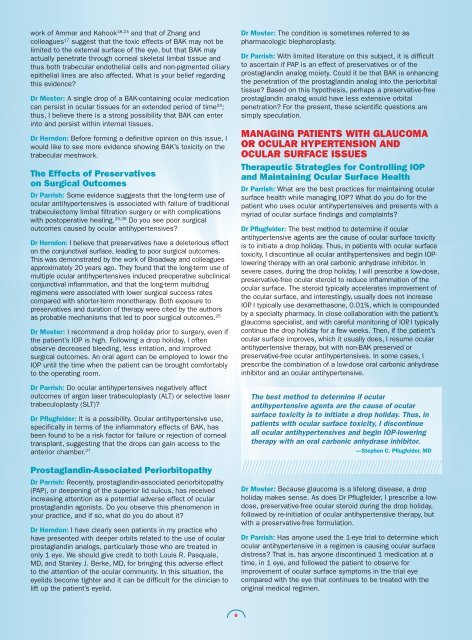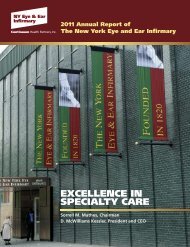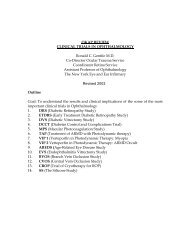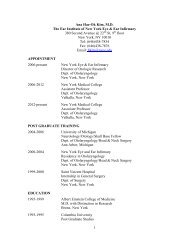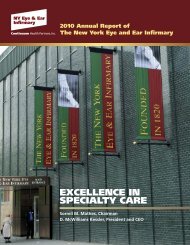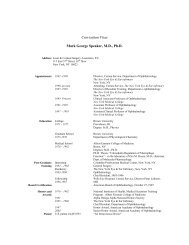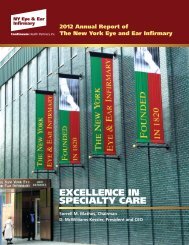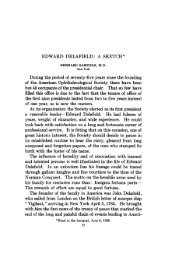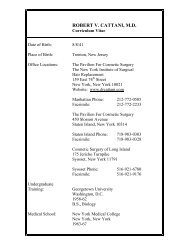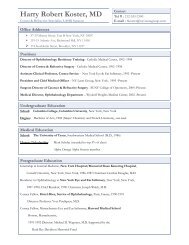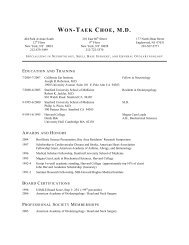The Impact on Glaucoma from the OUTSIDE IN - New York Eye and ...
The Impact on Glaucoma from the OUTSIDE IN - New York Eye and ...
The Impact on Glaucoma from the OUTSIDE IN - New York Eye and ...
You also want an ePaper? Increase the reach of your titles
YUMPU automatically turns print PDFs into web optimized ePapers that Google loves.
work of Ammar <strong>and</strong> Kahook 18,23 <strong>and</strong> that of Zhang <strong>and</strong><br />
colleagues 17 suggest that <strong>the</strong> toxic effects of BAK may not be<br />
limited to <strong>the</strong> external surface of <strong>the</strong> eye, but that BAK may<br />
actually penetrate through corneal skeletal limbal tissue <strong>and</strong><br />
thus both trabecular endo<strong>the</strong>lial cells <strong>and</strong> n<strong>on</strong>-pigmented ciliary<br />
epi<strong>the</strong>lial lines are also affected. What is your belief regarding<br />
this evidence?<br />
Dr Moster: A single drop of a BAK-c<strong>on</strong>taining ocular medicati<strong>on</strong><br />
can persist in ocular tissues for an extended period of time 24 ;<br />
thus, I believe <strong>the</strong>re is a str<strong>on</strong>g possibility that BAK can enter<br />
into <strong>and</strong> persist within internal tissues.<br />
Dr Hernd<strong>on</strong>: Before forming a definitive opini<strong>on</strong> <strong>on</strong> this issue, I<br />
would like to see more evidence showing BAK’s toxicity <strong>on</strong> <strong>the</strong><br />
trabecular meshwork.<br />
<str<strong>on</strong>g>The</str<strong>on</strong>g> Effects of Preservatives<br />
<strong>on</strong> Surgical Outcomes<br />
Dr Parrish: Some evidence suggests that <strong>the</strong> l<strong>on</strong>g-term use of<br />
ocular antihypertensives is associated with failure of traditi<strong>on</strong>al<br />
trabeculectomy limbal filtrati<strong>on</strong> surgery or with complicati<strong>on</strong>s<br />
with postoperative healing. 25,26 Do you see poor surgical<br />
outcomes caused by ocular antihypertensives?<br />
Dr Hernd<strong>on</strong>: I believe that preservatives have a deleterious effect<br />
<strong>on</strong> <strong>the</strong> c<strong>on</strong>junctival surface, leading to poor surgical outcomes.<br />
This was dem<strong>on</strong>strated by <strong>the</strong> work of Broadway <strong>and</strong> colleagues<br />
approximately 20 years ago. <str<strong>on</strong>g>The</str<strong>on</strong>g>y found that <strong>the</strong> l<strong>on</strong>g-term use of<br />
multiple ocular antihypertensives induced preoperative subclinical<br />
c<strong>on</strong>junctival inflammati<strong>on</strong>, <strong>and</strong> that <strong>the</strong> l<strong>on</strong>g-term multidrug<br />
regimens were associated with lower surgical success rates<br />
compared with shorter-term m<strong>on</strong>o<strong>the</strong>rapy. Both exposure to<br />
preservatives <strong>and</strong> durati<strong>on</strong> of <strong>the</strong>rapy were cited by <strong>the</strong> authors<br />
as probable mechanisms that led to poor surgical outcomes. 25<br />
Dr Moster: I recommend a drop holiday prior to surgery, even if<br />
<strong>the</strong> patient’s IOP is high. Following a drop holiday, I often<br />
observe decreased bleeding, less irritati<strong>on</strong>, <strong>and</strong> improved<br />
surgical outcomes. An oral agent can be employed to lower <strong>the</strong><br />
IOP until <strong>the</strong> time when <strong>the</strong> patient can be brought comfortably<br />
to <strong>the</strong> operating room.<br />
Dr Parrish: Do ocular antihypertensives negatively affect<br />
outcomes of arg<strong>on</strong> laser trabeculoplasty (ALT) or selective laser<br />
trabeculoplasty (SLT)?<br />
Dr Pflugfelder: It is a possibility. Ocular antihypertensive use,<br />
specifically in terms of <strong>the</strong> inflammatory effects of BAK, has<br />
been found to be a risk factor for failure or rejecti<strong>on</strong> of corneal<br />
transplant, suggesting that <strong>the</strong> drops can gain access to <strong>the</strong><br />
anterior chamber. 27<br />
Prostagl<strong>and</strong>in-Associated Periorbitopathy<br />
Dr Parrish: Recently, prostagl<strong>and</strong>in-associated periorbitopathy<br />
(PAP), or deepening of <strong>the</strong> superior lid sulcus, has received<br />
increasing attenti<strong>on</strong> as a potential adverse effect of ocular<br />
prostagl<strong>and</strong>in ag<strong>on</strong>ists. Do you observe this phenomen<strong>on</strong> in<br />
your practice, <strong>and</strong> if so, what do you do about it?<br />
Dr Hernd<strong>on</strong>: I have clearly seen patients in my practice who<br />
have presented with deeper orbits related to <strong>the</strong> use of ocular<br />
prostagl<strong>and</strong>in analogs, particularly those who are treated in<br />
<strong>on</strong>ly 1 eye. We should give credit to both Louis R. Pasquale,<br />
MD, <strong>and</strong> Stanley J. Berke, MD, for bringing this adverse effect<br />
to <strong>the</strong> attenti<strong>on</strong> of <strong>the</strong> ocular community. In this situati<strong>on</strong>, <strong>the</strong><br />
eyelids become tighter <strong>and</strong> it can be difficult for <strong>the</strong> clinician to<br />
lift up <strong>the</strong> patient’s eyelid.<br />
Dr Moster: <str<strong>on</strong>g>The</str<strong>on</strong>g> c<strong>on</strong>diti<strong>on</strong> is sometimes referred to as<br />
pharmacologic blepharoplasty.<br />
Dr Parrish: With limited literature <strong>on</strong> this subject, it is difficult<br />
to ascertain if PAP is an effect of preservatives or of <strong>the</strong><br />
prostagl<strong>and</strong>in analog moiety. Could it be that BAK is enhancing<br />
<strong>the</strong> penetrati<strong>on</strong> of <strong>the</strong> prostagl<strong>and</strong>in analog into <strong>the</strong> periorbital<br />
tissue? Based <strong>on</strong> this hypo<strong>the</strong>sis, perhaps a preservative-free<br />
prostagl<strong>and</strong>in analog would have less extensive orbital<br />
penetrati<strong>on</strong>? For <strong>the</strong> present, <strong>the</strong>se scientific questi<strong>on</strong>s are<br />
simply speculati<strong>on</strong>.<br />
MANAG<strong>IN</strong>G PATIENTS WITH GLAUCOMA<br />
OR OCULAR HYPERTENSION AND<br />
OCULAR SURFACE ISSUES<br />
<str<strong>on</strong>g>The</str<strong>on</strong>g>rapeutic Strategies for C<strong>on</strong>trolling IOP<br />
<strong>and</strong> Maintaining Ocular Surface Health<br />
Dr Parrish: What are <strong>the</strong> best practices for maintaining ocular<br />
surface health while managing IOP? What do you do for <strong>the</strong><br />
patient who uses ocular antihypertensives <strong>and</strong> presents with a<br />
myriad of ocular surface findings <strong>and</strong> complaints?<br />
Dr Pflugfelder: <str<strong>on</strong>g>The</str<strong>on</strong>g> best method to determine if ocular<br />
antihypertensive agents are <strong>the</strong> cause of ocular surface toxicity<br />
is to initiate a drop holiday. Thus, in patients with ocular surface<br />
toxicity, I disc<strong>on</strong>tinue all ocular antihypertensives <strong>and</strong> begin IOPlowering<br />
<strong>the</strong>rapy with an oral carb<strong>on</strong>ic anhydrase inhibitor. In<br />
severe cases, during <strong>the</strong> drop holiday, I will prescribe a low-dose,<br />
preservative-free ocular steroid to reduce inflammati<strong>on</strong> of <strong>the</strong><br />
ocular surface. <str<strong>on</strong>g>The</str<strong>on</strong>g> steroid typically accelerates improvement of<br />
<strong>the</strong> ocular surface, <strong>and</strong> interestingly, usually does not increase<br />
IOP. I typically use dexamethas<strong>on</strong>e, 0.01%, which is compounded<br />
by a specialty pharmacy. In close collaborati<strong>on</strong> with <strong>the</strong> patient’s<br />
glaucoma specialist, <strong>and</strong> with careful m<strong>on</strong>itoring of IOP, I typically<br />
c<strong>on</strong>tinue <strong>the</strong> drop holiday for a few weeks. <str<strong>on</strong>g>The</str<strong>on</strong>g>n, if <strong>the</strong> patient’s<br />
ocular surface improves, which it usually does, I resume ocular<br />
antihypertensive <strong>the</strong>rapy, but with n<strong>on</strong>-BAK preserved or<br />
preservative-free ocular antihypertensives. In some cases, I<br />
prescribe <strong>the</strong> combinati<strong>on</strong> of a low-dose oral carb<strong>on</strong>ic anhydrase<br />
inhibitor <strong>and</strong> an ocular antihypertensive.<br />
<str<strong>on</strong>g>The</str<strong>on</strong>g> best method to determine if ocular<br />
antihypertensive agents are <strong>the</strong> cause of ocular<br />
surface toxicity is to initiate a drop holiday. Thus, in<br />
patients with ocular surface toxicity, I disc<strong>on</strong>tinue<br />
all ocular antihypertensives <strong>and</strong> begin IOP-lowering<br />
<strong>the</strong>rapy with an oral carb<strong>on</strong>ic anhydrase inhibitor.<br />
—Stephen C. Pflugfelder, MD<br />
Dr Moster: Because glaucoma is a lifel<strong>on</strong>g disease, a drop<br />
holiday makes sense. As does Dr Pflugfelder, I prescribe a lowdose,<br />
preservative-free ocular steroid during <strong>the</strong> drop holiday,<br />
followed by re-initiati<strong>on</strong> of ocular antihypertensive <strong>the</strong>rapy, but<br />
with a preservative-free formulati<strong>on</strong>.<br />
Dr Parrish: Has any<strong>on</strong>e used <strong>the</strong> 1-eye trial to determine which<br />
ocular antihypertensive in a regimen is causing ocular surface<br />
distress? That is, has any<strong>on</strong>e disc<strong>on</strong>tinued 1 medicati<strong>on</strong> at a<br />
time, in 1 eye, <strong>and</strong> followed <strong>the</strong> patient to observe for<br />
improvement of ocular surface symptoms in <strong>the</strong> trial eye<br />
compared with <strong>the</strong> eye that c<strong>on</strong>tinues to be treated with <strong>the</strong><br />
original medical regimen.<br />
6


